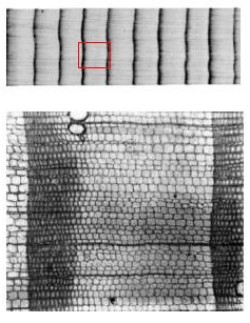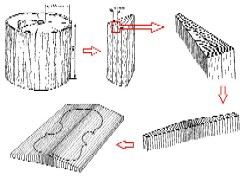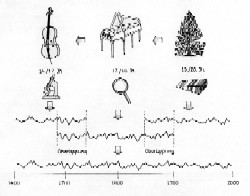|
| To explain the methodology, frequently asked questions concerning dendrochronology on musical instruments are listet below.
Where does the term dendrochronology come from?
The term dendrochronology is put together using the Greek words déndron which means tree, chrónos which means time and lógos which is the word for science. If translated literally dendrochronology means science of the tree time.
What is dendrochronology?
Dendrochronology or annual ring analysis is the determination of wood using the different widths of its annual rings. The width of the annual rings of trees is mainly determined by exogenous influences, which means outer influences. The most important exogenous influences are temperature, precipitation, and the location of the tree. The tree forms a very unique sequence of annual ring widths depending on location and geographical area respectively. Each annual ring is formed from a lighter coloured and a darker coloured zone, the earlywood and the latewood (fig. 1).
Which parts of the musical instruments are being examined?
With keyboard instruments it is the resonance board, with string instruments it is the belly. Exact measurements are possible on these parts because they are split from the log and show a strict radial structure (fig. 2).
These parts are made using what kind of species?
The instrument parts mentioned above are usually made using spruce (Picea abies L. Karst.). In rare cases true fir (Abies alba Mill.) is being used. Dendrochronological measurements on bottoms and frames of string instruments are not possible since the used maple wood (Acer pseudoplatanus L. or. A. platanoides L.) is not suited for dating.
Is it necessary to take a sample for dendrochronological measurements?
No, the dendrochronological measurements on musical instruments are non-destructive. The widths of the annual rings are determined using either a magnifying glass or a microscope. No sample needs to be taken, but sometimes it is helpful to remove the strings.
Is it possible to know the age of the instrument right after measuring the annual ring widths?
No, using the measured annual ring widths an annual ring curve is being generated and compared to a preexisting reference chronology. It is possible to determine the last/youngest measured annual ring from the musical instrument by moving the graph along the axis of time on the reference chronology. This chronological dating is not a proof of genuineness; it is only a statement about the age of the wood used to build the instrument.
How many annual rings are necessary to date an instrument?
In general it is possible to use 50 annual rings but better would be 100; these are still no guaranty. Right now, the dating quota is around 80%.
Is the youngest/last annual ring the year when the instrument was built?
It is only possible to determine the terminus post quem, which is the earliest possible date the tree could be cut down. To determine the difference between the dendrochronological dating and the art historical classification:
The storage time of the lumber and the amount of annual rings which have been cut off when the instrument was manufactured. It is possible that one or two millimetres of wood have been cut off when the individual parts were put together. It is possible that 2 to 10 annual rings could have been lost that way.
How do you build a reference chronology?
A chronology to date a musical instrument is based on a tree species (here: Spruce) that was cut down in the present but its annual rings go all the way back into the 18th century. Based on musical instruments from known builders or source so called ?swimming chronologies? can be derived. This way one has two groups of trees that have possibly existed together during a certain time and thus show similar annual ring patterns. If this is the case, it is possible to date the ?swimming chronology? by using the reference chronology. It might also be possible to extent the reference chronology by using the information contained in the ?swimming chronology? using the overlap method (fig. 3).
Is dendrochronology the same as the radiocarbon (C14) method?
No, the radio carbon dating method is a physical method and is destructive. In the time range from 1700 to 1900 the radio carbon method is not able to provide definite results.
|
|
 |
 |
| fig. 1: Earlywood and latewood. |
 |
 |
 |
|
 |
 |
 |
|
|
|